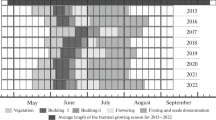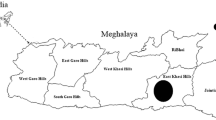Abstract
By the methods of morphological anatomy and investigation in the sample fields, the main studies were carried out such as morphological anatomy of reproductive organs, birch population’s reproductive ages, reproductive allotment value and seed behavior. The relationship between birch population and their surroundings was studied. The results showed that birch’s flower organs and its seeds were suitable well for spreading by wind. The seeds by wind can fly far away in a short time. The quantity of seed spreading greatly varied with different communities. Birch’s reproduction age can be changed in different ecological surroundings. The reproductive allotment value of birch was obviously different at different reproductive stages. In the mesic habitat, birch can grow well. The lowest reproductive age of them was 12, average age 15. In most cases the age of branches to bearing fruits was more than 18. The order of reproductive allotment values was as follows: a flowering phase > flower bud phase > fruit phase.
Similar content being viewed by others
References
Zhou Yiliang, Tong Shilin and Nie Shaoquan. 1986. Ligneous flora of Heilongjiang [M]. Harbin: Heilongjiang Science Press, 185–199.
Chen Zhiduan. 1994. Phylogeny and phytogeography of theBetulaceae [J]. Acta Phytotaxonomica Sinica,32(1): 1–31.
Sun Bing, Yang Guoting, Chi Fuchanget al. 1994a. Study on the spatial pattern ofBetula platyphylla population [J]. Bulletin of Botanical Research,14(2): 201–207.
Sun Bing, Yang Guoting, Li Honget al. 1994b. Study on the age structure ofBetula platyphylla population and the succession of its community [J]. Journal of Northeast Forestry University,22 (3): 43–47.
Chen Zhiduan. 1991. Pollen morphology of thebetulaceae[J]. Acta Phytotaxonomica. Sinica,29(6): 494–503.
Su Zhixian, Zhong Zhangcheng, Yang Wanqinet al.1996. Studies on the reproductive ecology ofGordonia acuminata population. I. Studies on the reproductive age, reproductive age structure and their affecting factors [J]. Acta Ecologica Sinica,16(5): 517–524.
Zhong Zhangcheng. 1995. Reproductive strategies of plant population [J]. Journal of Chinese Ecology,14 (1): 37–42.
Yang Yunfei. 1990. The study on seed dispersal ofpuccinellia tenuiflora on alkalization meadow in the Songnen plain of China [J]. Acta Ecologica Sinica,10(3): 288–290.
Yang Yunfei and Zhu Tingcheng. 1991. The study on seed rain change ofStipa grandis community in the songnen plain of China [J]. Acta Phytoecologicaet Geobotanica Sinica,15(1): 46–54.
Author information
Authors and Affiliations
Rights and permissions
About this article
Cite this article
**ao-ying, Y., Zi-jun, M., Hui-yan, G. et al. Reproductive strategies and seeds behavior ofBetula platyphylla Suk. population. Journal of Forestry Research 11, 241–244 (2000). https://doi.org/10.1007/BF02844969
Received:
Issue Date:
DOI: https://doi.org/10.1007/BF02844969




